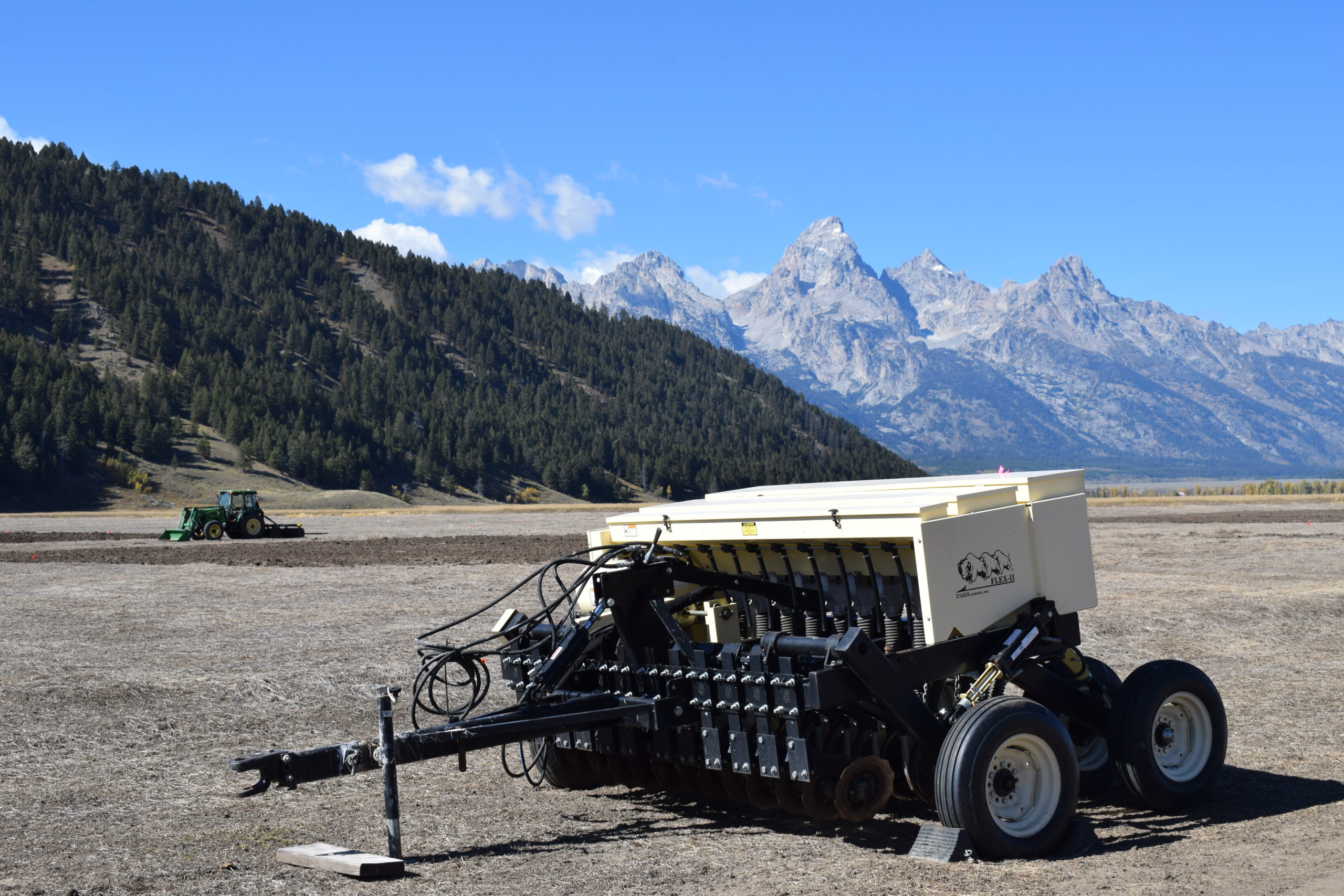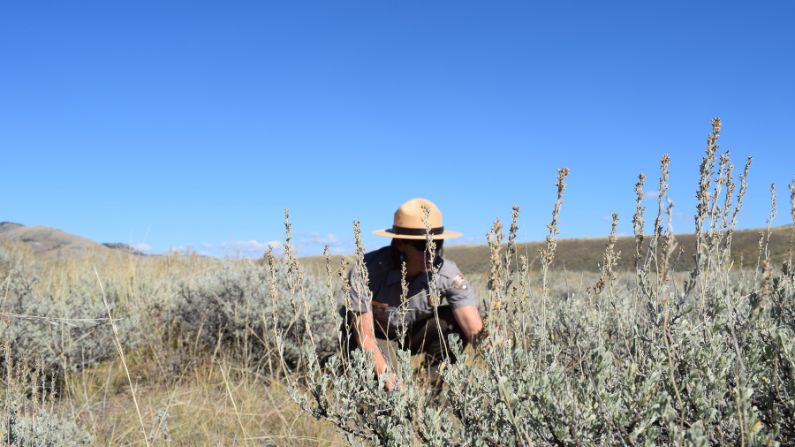On a sunny, windy fall day in Grand Teton National Park, the mountains loomed over a plot of flat valley land in the park’s southern section near Mormon Row. The 95-acre site, known as Antelope Flats, is a bottleneck for mule deer, elk and pronghorn, which all funnel through from the Gros Ventre Wilderness during their regular migrations.
However, on this early October day, the land was empty. No animals. No plants. Just dirt. The plot was originally covered in sagebrush, but homesteaders removed the native plants in the late 1800s and planted non-native pasture grasses in their place to create hay fields for cattle to graze in.
Park staff took those invasive grasses out last year and hope the land will soon be filled with native sagebrush. Ecologist Laura Jones is leading the sagebrush restoration project, which is just one of many similar projects in the park.
“We see some kind of heavy equipment,” Jones said, pointing to a nearby tractor tilling the soil. “Behind me is the seed drill that will be used to seed much of the area.”

A sagebrush restoration site, in Antelope Flats, sits in front of the Teton Range. (Hanna Merzbach/KHOL)
In 2007, Grand Teton set out to restore sagebrush to 4,500 acres of valley land, and it’s nearly a third of the way there: So far, the park has either restored or is in the process of restoring nearly 1,400 acres.
That includes the Antelope Flats area. Even though the homesteaders are long gone, their lasting impact on the environment remains, Jones said.
“For species here in the park where we are supporting a diversity of native flora and fauna, this almost monoculture doesn’t provide the same ecosystem processes and services to the wildlife [as sagebrush],” she said.
Now, with those grasses finally gone, park staff is tilling the land to change the soil properties before planting the sagebrush seeds later this fall. The plants could take over 20 years to fill in. In the meantime, Grand Teton will be monitoring progress along with researchers from the University of Wyoming.
The seeds were all hand-collected from other areas of the national park, a strategy that gives the plants the best chance of being fit for the environment. And sagebrush isn’t the only plant that’s getting a second chance.
“It’s also other shrubs like bitterbrush and rabbit brush and a diversity of grasses and wildflowers,” Jones said. “That diversity of life, of plants, supports wildlife throughout the whole year.”
A healthy sagebrush habitat could ease migration for the many animals that flow through the valley. A plant commonly paired with sagebrush, bitterbrush, is an important food source for moose. Even grizzlies rely on sagebrush, digging up the plants and eating their roots.
For decades, though, the fight to protect sagebrush habitats has centered on conservation for just one species: sage grouse. The birds rely on sagebrush for food and protective cover throughout the year. Now experts across the nation are taking a broader approach and prioritizing the entire ecosystem, which supports a total of 350 species. Experts say all of these species have value to not only the ecosystem, but to local economies that rely on recreation and tourism, such as Jackson.
On Sept. 22, a team of scientists from a dozen organizations published a report mapping out the many threats to the sagebrush ecosystem, such as invasive grasses and wildfires. The data shows that the West is losing over one million acres of sagebrush a year. The authors are urging government agencies and conservationists to focus on defending areas with sagebrush that’s already thriving — like Wyoming.
“You’re getting the best bang for your buck,” said Zack Wurtzebach, one of the authors of the report and a program director at the Center for Large Landscape Conservation in Bozeman. “It just makes more sense to work outwards, whereas you’re going to have an easier time restoring and addressing stressors such as conifer encroachment or invasive annual grasses than going to one of those places (where) they’re just overrun with them.”
Unlike some of these places, sagebrush in Wyoming doesn’t need as much work: The report showed that the state has the largest intact sagebrush ecosystem in the West. This is likely because Wyoming’s soil and climate make it resistant to invasive annual grasses and wildfires.
The Great Basin — which includes much of Nevada and Utah and parts of California and Oregon — has been hit by megafires that take out native sagebrush and give way to invasive grasses, but Wyoming has been a bit more lucky.
Still, Wurtzebach said this means conservation and restoration work is all the more important.
“While the picture in Wyoming is really good — Wyoming is a stronghold for sagebrush habitat — the data shows there are some problem areas, particularly in drier areas like the Bighorn Basin,” he said. “I think a key message moving forward with all this is, it’s good but there’s still a lot of work that needs to be done to keep it good.”
Back in Grand Teton National Park, staff and volunteers are doing just that. They’re investing in areas where work is needed and protecting the sites that are already thriving. This includes the expansive sagebrush flats that stretch out on either side of Teton Park Road and Highway 89.
Jones, the ecologist, investigated one of those sites off the highway — a notable contrast with the Antelope Flats site.
“We’re looking at a healthy, intact sagebrush ecosystem … like a third cover of sagebrush,” she said, while kneeling down to get a closer look at the plants. “We also have a lot of grasses — native grass species”
Jones hopes that one day the Antelope Flats site will look like this one. Of course, that won’t be for decades, she said, but what puts down roots now will benefit Grand Teton for years to come.






